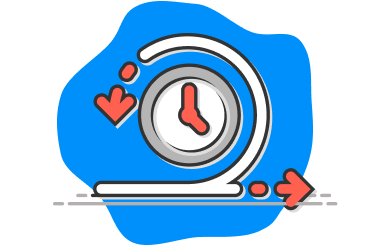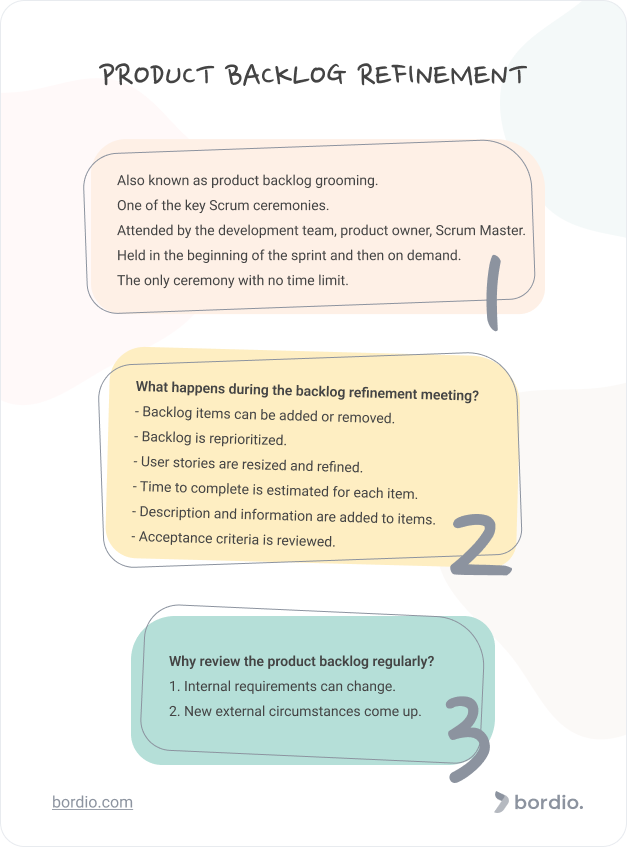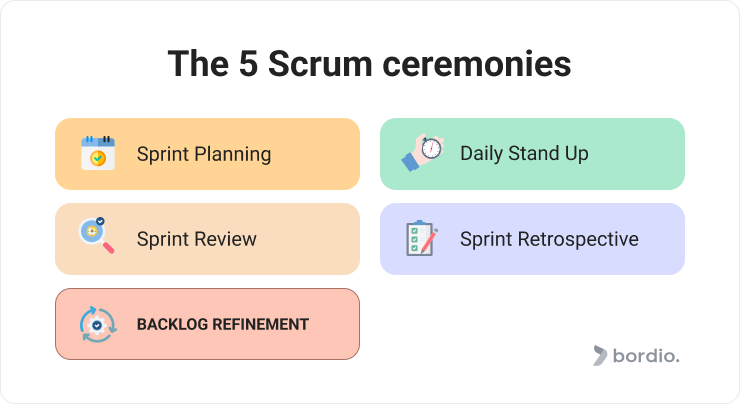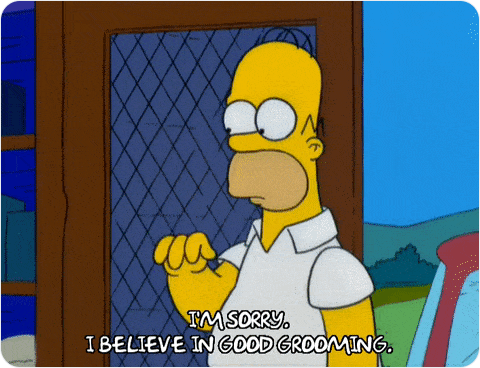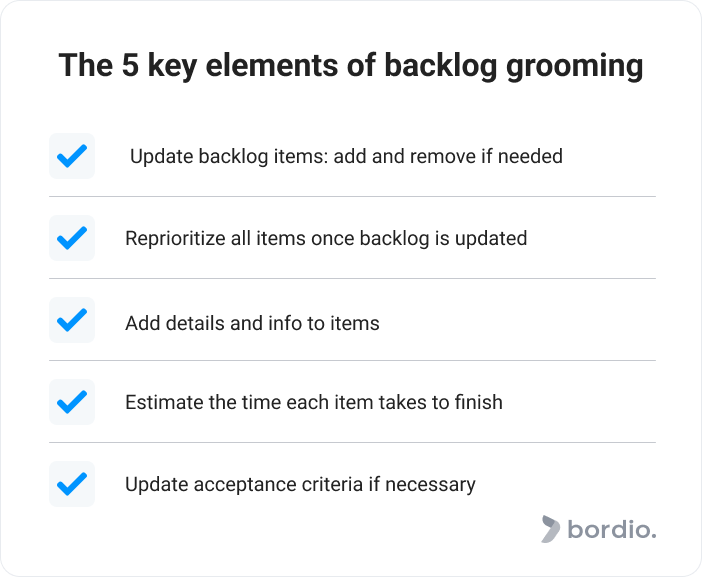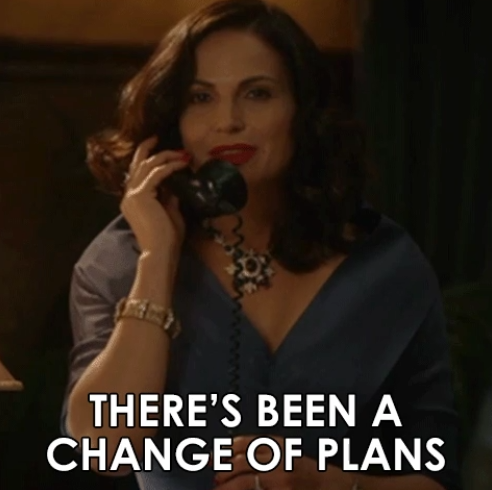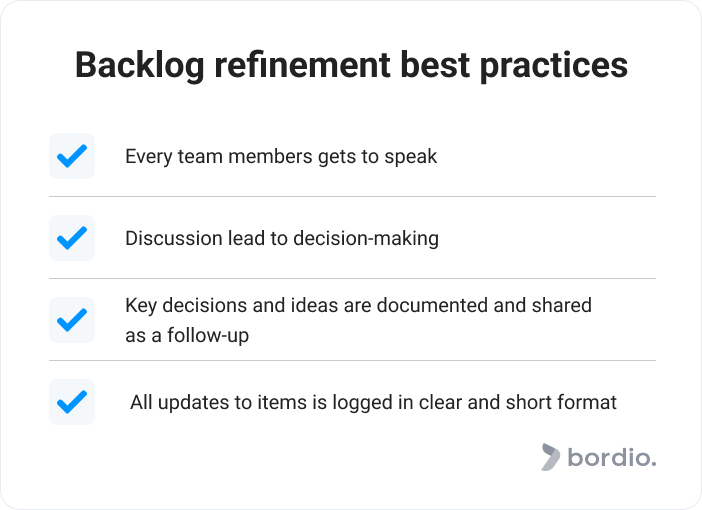Scrum pays a lot of attention to efficiency, only doing what’s necessary, and responding to changes quickly. To achieve all that, the Scrum team works through short periods of time called sprints and runs several Scrum ceremonies per sprint to support fast-paced progress.
Product backlog refinement is one of those ceremonies that are integral to the project’s success.
In this article, we will talk about what product backlog refinement implies, why it’s necessary for all Agile teams, and how to organize it in the best way possible.
What is product backlog refinement?
Product backlog refinement is sometimes called product backlog grooming, and we will use those terms interchangeably in the article.
Product backlog refinement meeting is one of the core Scrum ceremonies where the team comes together to review and update each user story in the product backlog for the project.
It is an ongoing activity required to support the basic Scrum philosophy which emphasizes the importance of delivering value more often through product increments at the end of each sprint (Scrum sprints last 2-4 weeks on average), instead of presenting one big solution at the end of the project. Use digital project management tools to schedule an event for everyone.
The meeting is scheduled on demand in everyone’s digital planners online and there is no minimum or maximum number of times it should be held per sprint or project. It is, however, recommended by the Scrum guide to do the grooming at the beginning of the sprint to ensure a healthy product backlog and that no unnecessary work gets done and time is used most efficiently. You can recommend your team to use simple schedule maker together to make it easier to report on things later.
What is the product backlog?
The product backlog is a prioritized list of work on the development’s team online to-do list that consists of product backlog items (PBIs). Items are drawn based on the user stories (also known as required deliverables). Because a new user story can be added at any point of the project, the backlog is ever-increasing, can easily get out of hand, and turn into a scope creep. To create an online to-do list, you can use for example in the free task organizer from Bordio.
The backlog can contain fully detailed user stories but also ideas and partial user stories which are then iterated in the backlog and finalized before being committed to a sprint backlog (that is created from product backlog) and further discussed in sprint planning meetings.
Product backlog should reflect the project vision and exclude any items that are no longer relevant or do not generate value.
The purpose and format of product backlog refinement
The product backlog refinement session is attended by the development team and product owner with optional attendance by Scrum Master.
Although traditionally the whole team is required to attend, sometimes you can choose to only invite some of the team members and that’s okay. If part of the development team is super busy and their interests can be represented by a colleague, then it’s safe to say they’re better off dealing with their current workload rather than adding one more meeting to the agenda. To make your project work flow easily you can also use time management tools online.
During the backlog refinement, the backlog is reprioritized, user stories are resized and refined in preparation for the next sprint. When breaking down backlog items, it is important to ensure that they can be finished within a sprint. So any big items have to be broken down into smaller tasks.
Unlike the rest of Scrum ceremonies, product backlog refinement is not time-bound. It can happen as many times as needed and continue for as long as necessary. Most of the time, Scrum teams stick to scheduling the ceremony in their online calendar planners at the beginning of the sprint and then once a week. The only number that Scrum framework identifies is that backlog refinement should take not more than 10% of the development team’s capacity.
The format is usually as follows: the team comes together (either virtually or in a meeting room) and goes through the product backlog one by one in a form of group discussion.
The key activities during the product backlog refinement meeting
Product backlog refinement meeting is filled with activities and is usually a fast-paced event. Here are the main things that most teams do, you can made your own list in software for work:
- Adding and removing backlog items.
- Reprioritizing all the items once the backlog is updated.
- Adding details to the items to simplify the future work with them.
- Analyzing the estimated time each of the items will take to finish.
- Reviewing acceptance criteria and making sure it is still relevant.
All these activities allow product owners and development teams to be better prepared for the upcoming sprint and not run into issues that could have been prevented. Dedicating enough energy and time to product backlog refinement meetings helps avoid situations where we have to push back important items selected for the current sprint, or even worse, fail the sprint completely.
Pro tip: Scrum team can do basic estimations during the backlog refinement meeting. However, the main estimation happens during the sprint planning meeting where team members review all backlog items and story points, check on acceptance criteria, and plan the workload for the sprint in their week planners. We also recommend using online planners every day to prioritize things to do.
By the end of the meeting, the Scrum team should have a shared understanding of what the product will look like and be able to do, how much time and effort is required to make it happen, and what the order of implementation is.
It’s important to have the officially scheduled meeting and run the backlog grooming regularly. This will eliminate or at least minimize the risks of building the wrong things, wasting time, and having to re-do the work. Without knowing what’s relevant and assigning priorities to each item, your project will drag for longer and you will risk ending up with mediocre results.
Why does the product backlog have to be updated throughout the project?
As we established earlier, the development team can run multiple product backlog meetings throughout the project lifetime, and even several within a single sprint. But is it really that necessary? Are we, by any chance, just wasting time? The answer is No.
Traditional project management approaches, like Waterfall or PRINCE2, have become less popular partly because they’re not flexible at all and fail to adapt to change. As a result, waterfall projects’ results are often dissatisfactory and irrelevant.
Agile Scrum, in turn, is very flexible and welcomes change as an opportunity. And working with change comes in many shapes and forms, one of them is working with product backlog regularly.
The times of stability and stillness are long gone. The world moves very fast and we have to keep up with it. Here are the examples of what can change and influence the product backlog over the course of the project:
-
Internal requirements change (stakeholders can have a change of heart or new perspective is brought up that affects some of the projects’ plans).
-
New external circumstances come up (like a competitor who announced features that we now also need to implement, or a global pandemic shuts the world down and some of our tools become irrelevant for the moment).
The Scrum team works through sprints. A sprint is a short period of time with a challenging agenda. The outcome of each sprint has to be a high-value product increment. Therefore, it is paramount to have your priorities straight before the sprint starts because there will be no time to deal with any backlog issues once the development team gets to work.
Making your product backlog refinement a success
Practice makes perfect. And the best advice we can give you is to have the meeting regularly, put effort into it, and the result will be good.
Still, there are a few tips that we can share to help you avoid the typical drawbacks that happen all the time. Here they are:
-
The best backlog refinement sessions happen when every team member gets a say. Make sure people’s opinions are heard, especially of those that are not directly involved in the PBI development. Different perspectives are key to success.
-
Healthy and energetic discussions are great but they need to lead somewhere. Stay focused and guide the conversation towards decision-making so that your ceremony has a clear outcome. Having Scrum Master attend the meeting would be great as they are specialists in Scrum ceremonies and will instantly spot when the conversation is not going anywhere.
-
Document the decisions and key ideas and send them out as a follow-up to the team. It helps keep information in mind and access quickly whenever needed. This can be done in scheduling programs for teams like weekly schedule planner online or schedule builder app from Bordio.
-
Log all updates to the backlog items in a clear and short format. Do it either on the go during the meeting or shortly after, before you forget the nuances and important details. Also, remove any points or tasks that are no longer relevant. It will help the project in general but also will make your next refinement sessions much more efficient as people won’t have to go through a ton of notes. This would usually be the job of the product owner but any team member can take care of it.
-
The product owner takes control of the refinement process to a point where he’s the only one making the decisions. If that happens on a regular basis, address the issue with a dedicated project specialist, whether it is an Agile coach or Scrum Master.
-
The Scrum team tries to fully resolve the issues associated with backlog items during the meeting. It’s okay to go through all the details of the item and the issues that came up. That allows us to have a full picture. Then, we move on to the next item and leave the problematic ones out. The ultimate goal of the ceremony is to go through the backlog and all user stories, so if some items contain risks or whatnot, they should be pushed back. The issue resolution has to happen outside of the ceremony.
The don’ts of product backlog refinement ceremony
There are some things that have no place in backlog refinement meeting:
Final thoughts on product backlog refinement
Backlog refinement is more than a discussion session. Although it is a great opportunity to have the team together and exercise team building, it requires everyone’s attention, focus, and input.
The tips we shared today will facilitate a successful refinement ceremony, but perhaps the most important tip is for all team members to have a sense of ownership over the backlog and feel a personal responsibility for keeping it up to date. We recommend using personal task tracker app and team time planner free.
Backlog refinement, when it is a regular meeting, improves overall project efficiency, keeps the backlog relevant and clean, and facilitates uninterrupted workflow.
